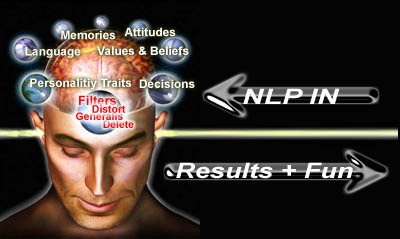
NLP (Neuro-Linguistic Programming) is one of the most advanced, highly complex and modern psychotherapeutic techniques, often used in conjunction with hypnotherapy to re-program the way the brain connects thoughts and stimuli in order to change behaviors and experiences.
The Basics
According to NLP practitioners, words and perceptions are the result of subconscious programming, and ailments will continue to persist as long as they remain unchallenged at the subconscious level. For example, in the case of anxiety disorder sufferers, irrational feelings of panic and fear are provoked by a subconscious response in any ordinary situation, and if this inaccuracy remains uninfluenced and modified at the subconscious level, the patient has little hope of changing this psychological condition.
As in the case of hypnotherapy, NLP is inherently patient-centered and operates on an understanding of three distinct yet interconnected principles to reprogram experiences at the subconscious level. However, unlike hypnotherapy, patients are generally not placed into trance-like states in order to target subconscious processes, although hypnotherapy is integral to some models of NLP conditioning.
“Neuro” involves the neural signals that work within the neurological symbols in order to send, receive and restore information.
“Linguistic” involves the language and messages that are submitted and received.
“Programming” involves the way the content or message is perceived, interpreted and converted to experiences, thoughts, sensations and feelings.
How it Works
In order to perceive and make sense of the world, everyone uses the five senses, which are called the representational system. The senses are visual (images), auditory (sounds), kinesthetic (touch and internal feelings), gustatory (tastes) and olfactory (smells). The representational images created using the five senses are called modalities in NLP therapy, and these images are innumerable and are readily altered. The filters, or constraints, our feelings, thoughts and value systems impose on a particular thought or concept are called sub-modalities.
To illustrate a simple thought using this complete model, consider a chair. The modality used to describe the thought of the chair might be wood, iron or four legs. These modalities may help one to think of a dining room chair, a kitchen chair, or an armchair in a living room. The image that is formed in the mind of a leather armchair in a living room is somehow influenced by the sub-modality of our thoughts and prejudices. Perhaps the chair imagined at a given moment is similar to one that really exists and is similar to one at home or at the office. Your modality image is tainted by experience, which forms part of your sub-modality.
Using this cognitive model of sense, modality and sub-modality, a NLP practitioner will focus upon subconsciously manipulating all three in order to produce lasting behavioral and attitudinal changes. The practitioner will analyze every word the patient speaks, connecting it to subconscious perceptions and ideas, identifying the root cause, as well as all body language and movement, through a series of question-answer conversations, entitled the “meta-model.” Of particular interest to the NLP practitioner is how sub-modality, thoughts, opinions and value systems skew, distort or manipulate true perceptions of reality.
Analyzing language patterns helps the NLP practitioner identify the patient’s true subconscious makeup and perceptions of reality, and once understood, the practitioner reconditions thoughts and underlying core beliefs to correct the ailment or troublesome behaviors.
Micheal Peak is an NLP practictioner, Master of Hypnotherapy, Psychology, Motivation and a Born Teacher. To learn more about please visit: http://www.peakmystique.com/cmd.php?af=1044398

No comments:
Post a Comment